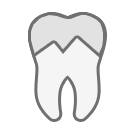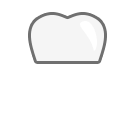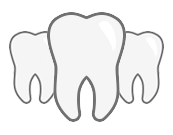Broken Teeth

White Fillings
For smaller cavities and tooth decay we normally use a tooth-coloured composite filling material that matches the shade of your surrounding natural teeth. You can also elect to have any existing metallic fillings replaced with tooth-coloured or ‘white’ fillings. The restoration is completed in one visit and your fillings will not be visible when you smile.
Inlays and onlays
Decayed or chipped teeth can often be repaired with white composite fillings that look natural. However, if the damage is too substantial, particularly on the back teeth, then an inlay or onlay would be recommended. Inlays or onlays can be made from a number of strong materials such as metals or ceramics.
An inlay is a small filling that fits into the biting surface of a tooth. An onlay covers a larger area of the tooth and is better suited to bigger cavities. Gold was traditionally used for these types of restorations. However, in recent times hard-wearing tooth-coloured porcelain and composite has become a more popular choice of material.
Crowns and bridges
A crown is a type of dental restoration used to fix teeth that have been broken or weakened by decay, or have been root treated. They restore the appearance as well as the strength of a broken down tooth.
Crowns were traditionally made from cast gold but modern materials include all-porcelain crowns which can closely mimic a natural tooth and eliminate the dark line often seen around old crowns.
Crowns are also used to anchor a bridge or denture firmly in place in the mouth. Bridges are simply crowns which are linked to false teeth to replace missing teeth.
Veneers
Are your teeth stained, chipped, or not aligned on top of each other? Veneers are a good treatment option to consider because they look like natural teeth and don’t require a major procedure. Veneers can also be used to close small gaps when braces are not suitable. If one tooth is slightly out of position, a veneer can sometimes be fitted to bring it into line with the others.
They are often made from porcelain. However, the most up-to-date techniques use a composite material and involve no preparation of the underlying tooth. This ultraconservative approach can give incredibly realistic results without damaging the natural teeth in any way.
Get in touch today – we’ll be happy to book you an appointment at our Chichester-based dentistry or help you with any queries.









